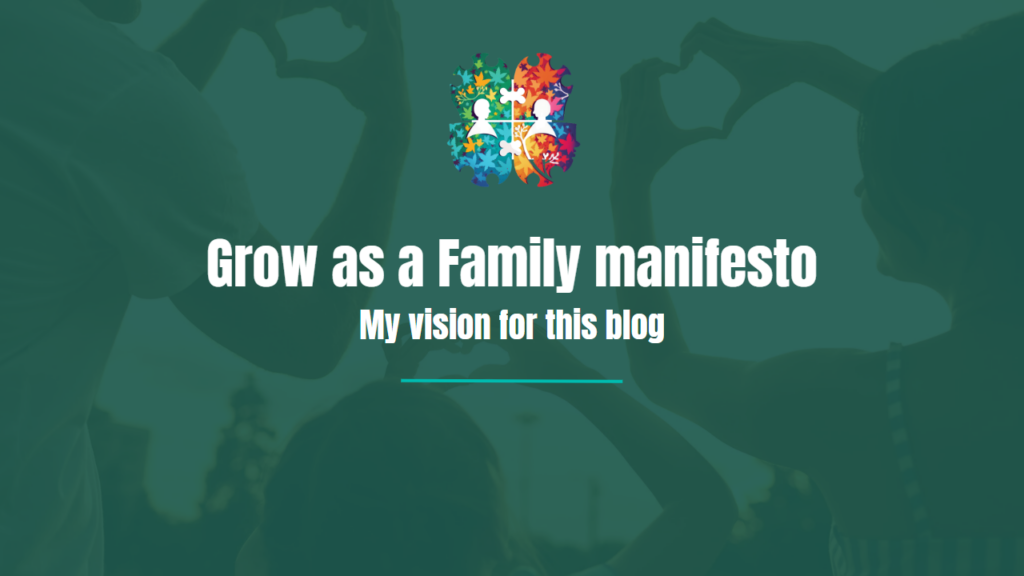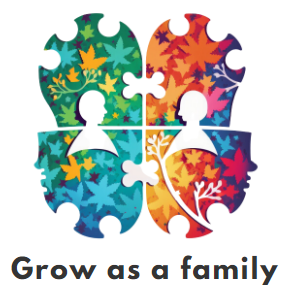
Welcome to Growasafamily! In this debut blog post, I’m excited to share with you the vision behind Growasafamily. It’s all about the belief that personal growth as a parent is crucial for creating a healthy, happy family. Just like in an airplane, where you need to put on your oxygen mask before helping others, we as parents must work on ourselves first. By improving and developing ourselves, we’re better able to positively impact our family members, especially our kids.
In this article, I’ll dive into the importance of personal growth, how we can influence and support our children, and how communication and shared goals can strengthen our family bond.
The importance of personal growth of the parent
So, who’s the most important person in any relationship? Be it a romantic partnership, a parent-child relationship, or something else, the answer is you! Sounds wild, right? But it’s not selfish. Think about this:
- Who do you genuinely influence? What can you control? How do others behave or how do you behave?
- When can you better influence others? When you feel good or bad? When you’re growing and bringing out the best in yourself or when you’re constantly struggling with yourself?
Here’s the deal: as a parent, you’ve gotta work on yourself first. You’re the most important because your actions and behaviors directly impact your kids and those around you. Kids learn by observing and imitating, so we parents are their first and greatest role models. By investing in ourselves, we show our children how to handle challenges and successes, and we create a stronger foundation for the entire family.
A lot of parents forget themselves and focus solely on their families. They don’t make time for self-care, personal growth, and development. They completely sacrifice themselves. But sometimes, they end up achieving the opposite of what they intended. I don’t wanna judge anyone because the intention is good: everyone wants the best for their family.
Remember the airplane example: in an emergency, you need to put on your oxygen mask first before helping others. That way, you can genuinely help others when you’re safe and stable yourself. The same applies to parenting. To take care of our children, we must first take care of ourselves—mentally, emotionally, and physically. Just like exercising to become fit, you need to actively work on your well-being. By working on ourselves, we’re more capable of tackling the challenges of parenting and creating a safe, supportive environment for our kids.
When we focus on our growth, we can better navigate the ups and downs of parenting and give our children the best version of ourselves. It’s the first and most crucial step in fostering a healthy, happy, and harmonious family dynamic.
The Child, the Great Imitator
Take a look at how kids play. They often pretend to be a teacher, mom, or dad, right? This imitation helps them learn a ton. As parents, our behavior is super important. “Actions speak louder than words” – you’ve heard it before. In parenting and family life, this means our actions have a greater impact on our children than what we say.
Kids are real spies and copycats. They look to us to understand how to behave and deal with challenges. For example, if we tell them to be patient but quickly lose our cool and get angry, they’re more likely to imitate our reactions than listen to what we say.

As parents, we need to set a good example and act according to the values we want to teach our kids. This doesn’t mean we have to be perfect, but we should be aware of our actions and how they affect our children. By working on our growth and improving our behavior, we give a powerful and positive example to our kids.
Always remember that what we do leaves a lasting impression, and our children learn a lot from our actions, even if we don’t explain it. So let’s do our best to demonstrate our values and beliefs in our daily lives, showing our kids that actions speak louder than words.
Using stories as a basis for communication with your child
It’s not easy to talk to your kids about concepts like growth mindset, proactivity, or gratitude. Often, they don’t understand (yet) or find it boring. Years ago, I noticed with my kids that turning it into a funny or engaging story worked way better.
I started reading about the role of stories before TV and the internet existed, and how reading aloud to children is beneficial. I became convinced that reading stories to our kids is super important for family communication. Stories play a vital role in children’s development and have many benefits for both language skills and social-emotional development.
The benefits of reading to children
Reading aloud to children has a bunch of benefits:
- Language development: Reading aloud helps kids learn new words, expand their vocabulary, and improve their sense of grammar and sentence structure. This develops their language skills while keeping it fun.
- Imagination and creativity: Stories stimulate kids’ imagination and encourage them to explore new worlds, characters, and situations. This boosts their creativity and inspires them to come up with their ideas and stories.
- Empathy and understanding: Through stories, children learn to put themselves in others’ shoes and understand different perspectives and emotions. This helps them develop empathy and compassion, crucial for healthy social relationships and emotional intelligence.
- Attention and concentration: Listening to stories helps kids develop their attention and concentration skills, which are super important for their schoolwork and personal growth.
- Quality time and connection: Reading aloud is an awesome way to spend quality time with your kids and build a deeper bond. It creates a safe and cozy atmosphere where you can chill together and enjoy the magic of stories.

Using stories as a basis for discussing themes
Stories are not only super fun and educational, but they’re also perfect for chatting with your family about important life lessons and moral values. Here are some ways stories can boost communication and conversations about morality:
- Conversation starters: Stories provide topics for discussions on various themes, like friendship, honesty, courage, and empathy. By choosing stories that fit your kids’ age and interests, you help them better understand these concepts and relate them to their own experiences.
- Moral dilemmas: Many stories present characters facing tough choices. This is a great opportunity to discuss with your children what they would do in such situations and which values and principles would guide their decisions.
- Reflection and critical thinking: Stories encourage children to think about the actions and motives of characters, the consequences of their choices, and the lessons they can learn. This stimulates their critical thinking skills and helps them consider moral issues from different perspectives.
- Expressing feelings and emotions: Stories give children a safe space to express their feelings and emotions, both about what happens in the story and their own lives. Talking together about the emotions stories evoke helps children recognize, name, and share their feelings.
- Shared values and norms: Discussing the morals of stories can help parents and children discover and strengthen shared values and norms. This builds a stronger bond and more mutual understanding within the family.
By using stories as a foundation for communication and discussing moral issues, we help our kids learn important life lessons, express their feelings and emotions, and build a stronger bond with us as parents. Let’s harness the power of stories to encourage open and meaningful communication within our family and grow in wisdom and love together.
Activities
By using stories as a foundation for communication and discussing moral issues, we help our children learn vital life lessons, express their feelings and emotions, and build stronger bonds with us as parents. Let’s harness the power of stories to foster open and meaningful communication in our families and grow together in wisdom and love.
Activities like reading stories are an ideal way to connect with your child. But how can you take it a step further and better convey the story’s message? That’s where super fun activities come in! These are small things you can do with your child that spark additional conversations about the topic. For each story, there are printable PDFs and images. If your child enjoys coloring, great! They can color a matching coloring page. Want to have deeper conversations about the topic with your child in the evening? Then use the journal that comes with the story. Think a cootie catcher (a paper fortune teller) is cool? Print it out and make one together. If you’re creative and like making your own stories, use the story maker—a set of cards that help you create an awesome story with your superhero and villain!
These activities play a crucial role in discussing feelings, problems, and obstacles.

On this blog, you’ll find the following:
- Printable images: Posters with pictures or quotes about emotions and feelings can serve as visual reminders for everyone in the family to be open and share their emotions. They can also spark conversations, allowing parents and children to talk together about what they feel and experience.
- Goal-setting templates: Setting goals with your children helps them organize their thoughts and feelings and learn how to tackle problems and obstacles. By setting and discussing goals together, children can express their worries and fears, and parents can help find solutions and overcome challenges.
- Journal templates: Keeping a journal can help children express their feelings and thoughts in a safe and structured way. Journal templates with specific questions or prompts can guide them in discussing their feelings, problems, and obstacles and in thinking about possible solutions or strategies for dealing with these challenges.
- Cootie catchers: Cootie catchers are a fun and interactive way to start conversations about feelings and emotions. By including questions or tasks about feelings, problems, and obstacles in the cootie catcher, children can playfully explore and share their emotions with their parents or siblings.
- Printable board games: Board games that encourage discussing feelings, problems, and obstacles can be a fun and educational activity for the whole family. By playing and talking together, family members learn to be open about their emotions and support each other in tackling problems and challenges.
In conclusion
In this blog post, I’ve explained the vision for Growasafamily. It was important to do so, perhaps more for myself than for you as a reader ;-). It provides clarity about what I want to achieve. So, let’s summarize! We discussed the importance of parents’ personal development and how it affects the health of the entire family. We talked about the proverb “actions speak louder than words” and how parents may provide the finest example for their children by developing personally. We also discussed the value of family communication, particularly when it comes to sharing stories and talking about morality. We provided tools and activities to assist parents and children identify and talk about their feelings, issues, and challenges.
I warmly invite you to join us on this journey of growth as individuals, children, and families. By applying the principles and insights from this blog post, you can work with your family to create a loving, supportive, and communicative environment where everyone can flourish. We encourage you to discover and use the activities and tools we offer to help your family grow and become stronger. Together, we can make a difference in our lives and our children’s lives, ensuring a healthy, happy, and harmonious future for our families. Let’s embrace this journey of growth and discovery and guide our families towards a life of joy, love, and connection.
As I write this blog post, I make a remarkable discovery. I’ve been so busy with my demanding full-time job, setting up this blog, doing research, and creating read-aloud books, that I realize I’ve become a bit of a background figure. That’s just me. When I’m passionate about something, I can get absorbed in it. Then I have to go back to what’s most important. What it’s all about. As Stephen Covey says, “First things first.” Quality time with my family! That’s where I’ll invest my time in the coming days. The rest of this blog will come…
Grow! As individuals, grow together, grow as a family!
Peter








